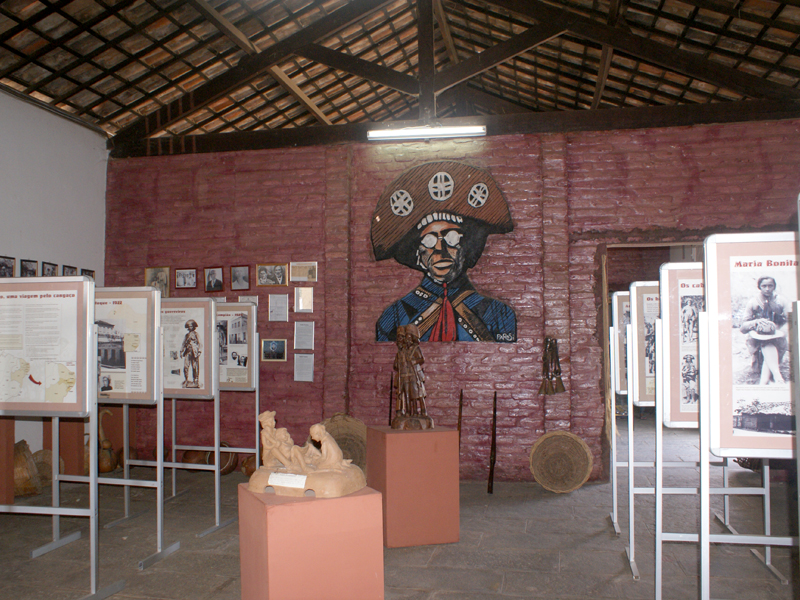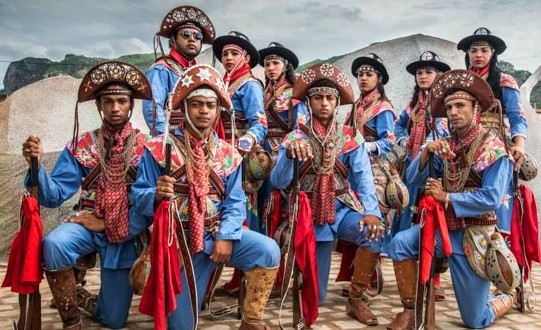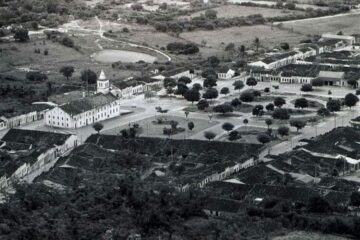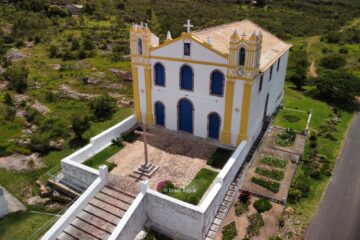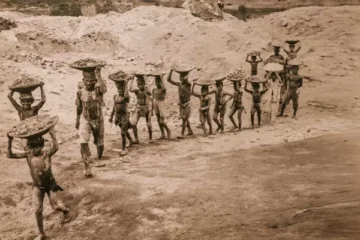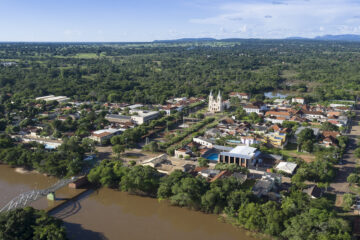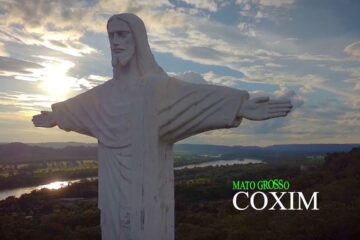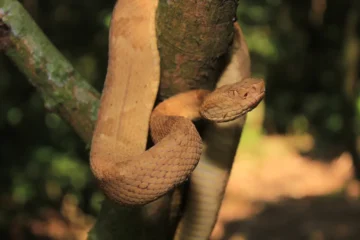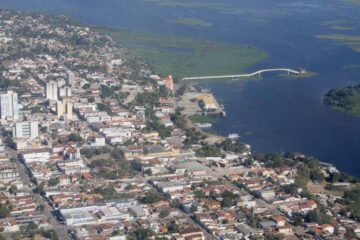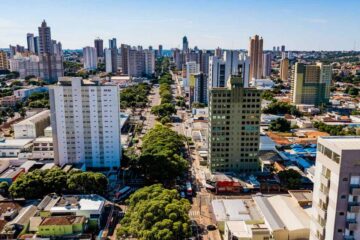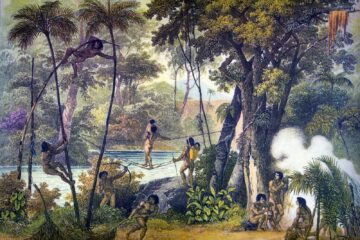Este post também está disponível em:
Português
English
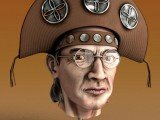
A visionary, fearless and intelligent warrior. No one denies Lampião’s virtues. Now researchers are questioning the true historical role of Virgulino Ferreira. by Lira Neto
They made murder a macabre ritual. The long dagger, up to 80 centimeters long, was thrust with a sharp blow into the base of the clavicle – the popular “soap dish” – of the victim.
The pointed blade cut through the flesh, severed arteries, punctured the lung, pierced the heart and, when removed, produced a spectacular squirt of blood. It was one less policeman or snitch in the caatinga – and one more dead in the cangaço’s accounts.
When they didn’t kill, they made a point of wounding, mutilating, leaving visible scars, so that the marks of violence would serve as an example. They drew deep cross-shaped wounds on men’s foreheads with knives, and disfigured women’s faces with hot cattle branding irons.
Exactly 70 years after the death of the main leader of the cangaço, Virgulino Ferreira da Silva, Lampião, the aura of heroism that for some time was tried to be attributed to the cangaceiros gives way to a less idealized interpretation of the phenomenon.
A series of books, theses and academic dissertations launched in recent years argues that it makes no sense to cultivate the myth of an idealistic Lampião, a primitive revolutionary, insurgent against the oppression of the latifundia and the injustice of the northeastern hinterland.
Virgulino would not be a romantic vigilante, a Robin Hood of the caatinga, but a cruel and bloodthirsty criminal, allied with colonels and large landowners.
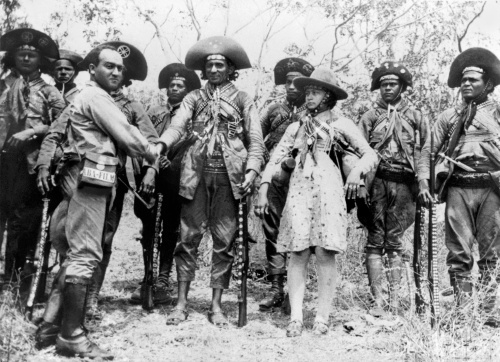
Contemporary historians, anthropologists and social scientists have come to the not very comfortable conclusion for the memory of the cangaço: in rural Brazil of the first half of the 20th century, the action of bands like Lampião’s played a role equivalent to that of the drug traffickers who today kidnap, kill and corrupt in the country’s large metropolises.
Cangaceiros and traffickers
It was the cangaceiros who introduced kidnapping on a large scale in Brazil.
They took hostages in exchange for money to finance new crimes. If they did not receive the ransom, they tortured and killed the victims by shooting or stabbing. Extortion was another source of income. They would send letters demanding astronomical sums of money not to invade towns, set fire to houses and shed innocent blood.
They offered safe conducts, with which they guaranteed protection to those who gave them shelter and cover, the so-called coiteiros. They were always ruthless with those who crossed their path: they raped, castrated, terrorized. They corrupted military officers and civil authorities, from whom they received weapons and ammunition.
An arsenal of weapons that was always more modern and more powerful than that used by the troops fighting them.
“Violence is more perverse and explicit where the largest contingent of the poor and excluded population is located. Before, banditry took place in the countryside; today organized crime is more evident on the outskirts of urban centers,” says anthropologist Luitgarde Oliveira Cavalcanti Barros, a professor at the State University of Rio de Janeiro and author of the book A Derradeira Gesta: Lampião e Nazarenos Guerreando no Sertão.
The professor points out similarities between the methods of the cangaceiros and the drug dealers: “Most of the residents of today’s favelas are not marginals. In the sertão, the cangaceiros were also a minority. But in both cases, the honest, hard-working population is subjected to the regime of terror imposed by the bandits, who dictate the rules and live off collective fear.”
In addition to fear, the cangaceiros exerted a fascination among the sertanejos. Joining the cangaço represented social ascension for a young man from the caatinga. It meant joining a community of men who boasted of their audacity and courage, individuals who exchanged the modorra of peasant life for a daily life full of adventures and dangers.
It was a way of accessing fast, blood-soaked money, won by fire and brimstone. “The correlation between the procedures of yesterday’s cangaceiros and today’s drug dealers is evident. Strictly speaking, they are old teachers and modern disciples,” says researcher Melquíades Pinto Paiva, author of Ecologia do Cangaço and a member of the Brazilian Historical and Geographical Institute.
Man and legend
Virgulino Ferreira da Silva reigned in the caatinga between 1920 and 1938. The origin of the cangaço, however, is lost in time. Long before him, since the 18th century, there were already armed bands acting in the sertão, particularly in the area where the cattle cycle in the Northeast took revenge, a territory where violence, the law of the colonels, misery and drought prevailed.
The word cangaço, according to most authors, was derived from “canga”, a piece of wood placed on the neck of the oxen. Like cattle, the bandits carried their belongings on their shoulders.
One of the forerunners of the cangaço was the legendary José Gomes, the madman Cabeleira, who terrorized the lands of Pernambuco around 1775.
Another who marked the era was Jesuíno Alves de Melo Calado, from Rio Grande do Sul (1844-1879), famous for distributing the food he looted from government trains among the poor. But the first to deserve the title of King of Cangaço, for the boldness of his actions, was the Pernambucan Antônio Silvino (1875-1944), the Golden Rifle.
Among his exploits, he tore up the tracks, chased engineers and kidnapped employees of Great Western, an English company that built railroads in the interior of Paraíba.
Lampião always claimed he entered the bandit life to avenge the murder of his father. José Ferreira, a driver of pack animals and small farmer in Serra Talhada (PE), was killed in 1920 by police sergeant José Lucena after a series of hostilities between the Ferreira family and neighbor José Saturnino.
In the backlands of that time, revenge and offended honor went hand in hand. Taking justice into one’s own hands was considered legitimate and the absence of revenge was understood as a symptom of moral laxity. “In my land,/ the cangaceiro is loyal and brave:/ swears he will kill and kills”, says the poem “Terra Bárbara”, by Jáder de Carvalho (1901-1985).
In the same year, 1920, Virgulino Ferreira joined the group of another famous cangaceiro, Sebastião Pereira e Silva, or Sinhô Pereira – according to some authors, who nicknamed him Lampião. Like everything in the biography of the Pernambucan, the reason for the codename is controversial.
Some say that the name came from the fact that he handled his rifle so quickly and skillfully that successive shots lit up the night. His right eye, blinded by glaucoma and aggravated by an accident with a thorn in the caatinga, did not impair his aim.
Others believe the version attributed to Sinhô Pereira, according to which Virgulino used the flash of a shot to find a cigarette that a colleague had dropped on the ground.
The cangaço had not had a prominent leader since 1914, when Antônio Silvino was arrested after a fight with the police. It was only in 1922, after taking over Sinhô Pereira’s gang, that Virgulino became the maximum leader of the cangaceiros.
An excellent strategist, Lampião distinguished himself by his bravery in fights with the police, as in 1927, in Riacho de Sangue, during a clash with men led by Major Moisés Figueiredo from Ceará. Lampião’s 50 men were surrounded by 400 policemen.
The shooting was raging and the victory of the police was imminent. Lampião ordered a cease-fire and the sepulchral silence of his band. The police fell into the trap. They advanced and, on getting close, were met with heavy fire. Surprised, the soldiers retreated.
His ability to outwit his pursuers earned him the reputation of possessing supernatural powers and, after escaping numerous ambushes, of having his body sealed shut. In the same month as the Riacho de Sangue raid, Lampião and his band were ambushed again. A traitor offered them a poisoned dinner in a house surrounded by police.
When the first cangaceiros began to feel ill, Virgulino realized the scam and tried to escape, but found himself trapped by a purposeful fire in the woods. What was supposed to be a trap ended up saving the cangaceiros’ skin: they disappeared into the smoke, as if by magic.
But Lampião’s greatest asset was that he cultivated a large network of coiteiros. This ensured the longevity of his career and the extent of his dominance. His gang’s activities extended to Alagoas, Ceará, Bahia, Paraíba, Pernambuco, Rio Grande do Norte and Sergipe. Lampião commanded a nomadic army of more than 100 men, almost always distributed in subgroups, which gave mobility and made it difficult for the police to act.
In 1926, in a tone of defiance and mockery, he even sent a letter to the governor of Pernambuco, Júlio de Melo, proposing the division of the state into two parts. Júlio de Melo was content with one. Lampião, self-proclaimed “Governor of the Sertão”, would rule the other.
There are disagreements – and passionate arguments – about the historical figure of Virgulino. Did he command collective rape sessions or, on the contrary, punish individuals in the gang who raped women? Did he castrate enemies, as did so many others involved in the cangaço?
There are controversies. “Lampião was neither a demon nor a hero. He was a cangaceiro. Many of the cruelties attributed to him were practiced by individuals from other gangs. I interviewed several former cangaceiros and none confirmed to me stories about rapes and castrations carried out personally by Lampião,” says researcher Amaury Corrêa de Araújo, author of seven books on the cangaço.
The narratives of old cangaceiros contrast with the version published by the newspapers of the time, which generally had the police as their main source. With so many stories surrounding the figure of Lampião, it is difficult to separate the man from the legend. “I think that’s precisely there, in this multiplicity of views and versions, the great strength of the character he was.
This is what helps us to understand his dimension as a myth,” explains French historian Élise Grunspan-Jasmin, author of Lampião: Senhor do Sertão (Edusp).
“Lampião VP”
A book recently released in France promises to raise the temperature of this discussion. Signed by the writer Jack de Witte, Lampião VP, still without a publisher in Brazil, compares the trajectory of the King of Cangaço with that of the Rio de Janeiro drug dealer Marcio Amaro de Oliveira, Marcinho VP, the protagonist of the book-report Abusado, a best-seller by journalist Caco Barcelos.
“What produces the violence in the favelas? Poverty, social injustice, the police and corrupt politicians. The same causes produce the same effects,” says De Witte. Historian and Unicamp professor Jayme Pinsky warns: “It is somewhat simplistic to compare cangaceiros and drug dealers. One runs the risk of committing the historiographical sin of anachronism.” That is to say: analyzing one historical moment based on concepts and ideas from another.
It has already been commonplace among specialists to interpret the “King of Cangaço” as a “social bandit”, an expression created by the English historian Eric Hobsbawm to define the outlaws who appeared in agrarian societies in transition to capitalism. In Bandidos (Forense Universitário), 1975, Hobsbawn cites Lampião, Robin Hood and Jesse James as examples of noble brigands, daring avengers, defenders of the oppressed.
The revolutionary image began to be drawn in 1935, when the National Liberation Alliance cited Virgulino as one of its political inspirers. The thesis was reinforced in 1963 with the release of a classic on the subject, Cangaceiros e Fanáticos, in which the author, Rui Facó, justifies the physical violence of the cangaço as a response to social violence. At the same time, federal deputy Francisco Julião, a representative of the Peasant Leagues and a political activist for agrarian reform, declared that Lampião was “the first man in the Northeast to fight against landlordism and arbitrariness”.
“Lampião was not a revolutionary. His will was not to act on the world to impose more justice on it, but to use the world to his advantage,” says historian Grunspan-Jasmin, echoing one of the greatest experts on the cangaço today, Frederico Pernambucano de Mello. A researcher at the Joaquim Nabuco Foundation and author of Guerreiros do Sol: Violência e Banditismo no Nordeste Brasileiro, Mello says that the cangaceiro and the colonel were not rivals.
The colonels offered weapons and protection to the cangaceiros, who in return provided militia service. Two of Lampião’s greatest co-nemeses were powerful men: the Bahian colonel Petronilo de Alcântara Reis and the army captain Eronildes de Carvalho, who would become governor of Alagoas. “I prefer the conservative classes: farmers, ranchers, merchants,” Virgulino said in a 1926 interview.
Marketeer of the caatinga
The idea that Lampião was an avenger is also contested by Mello. He argues that in almost 20 years of cangaço, Lampião would never have made an effort to take revenge on Lucena and Saturnino, the policeman and former neighbor responsible for his father’s murder.
According to one of Virgulino’s men, Miguel Feitosa, the Medalha, Saturnino had even sent a uniform and a cut of cloth in order to seal peace between them. A bearer would have thanked him for Lampião.
The same Medalha said that former soldier Pedro Barbosa da Cruz had proposed killing Lucena for money. “Leave it alone, these are old questions”, Lampião would have replied. According to the author of Guerreiros do Sol, the cangaceiros used the discourse of personal revenge and charitable gestures as “ethical shields” for their acts of banditry.
Despite the arduous life, those who entered the cangaço could hardly (or wanted to) leave it. There was a notorious pride in belonging to the gangs, also revealed in the cangaceiros’ clothing. The excess of props, the decorations on the hats, the colorful embroidery were typical of the final moments of the cangaço. Lampião was a man very concerned with his public image, which helped him to remain in the national memory.
The King of Cangaço was also the king of personal marketing. Just as he loved to appear in newspapers and magazines, even allowing himself to be photographed and even filmed, he made his warrior costume an ostentatious and vain trademark. “In this, perhaps only the medieval European knight or the oriental samurai can rival our captain of the cangaço”, wrote Pernambucano de Mello.
Anthropologist Luitgarde Barros sees another point in common with today’s banditry: “Drug traffickers also like to flaunt their bandit status and have a characteristic visual code, consisting of hoods and tattoos of skulls scattered over their bodies.”
Police violence is another aspect that brings Lampião’s universe closer to the world of drug trafficking. As is the case today in favelas dominated by organized crime, the truculence of the sertanejos gangs was matched only by the brutality of the volantes – the police forces whose soldiers were nicknamed “monkeys” by the cangaceiros.
In the golden days of the cangaço, there was little difference between the actions of bandits and soldiers. They often dressed alike – which led to confusion – and some would band together with the others. Cangaceiros like Clementino José Furtado, or Quelé, left the group and joined the ranks of the volantes. The bandit Mormaço made the opposite move. He had been a police bugler before joining Lampião.
As is common in the history of most criminals, a tragic and violent death marked the end of Virgulino’s days. Betrayed by one of his trusted cohorts, Pedro de Cândida, who was tortured by the police to denounce the gang’s whereabouts, Lampião was surprised in his hideout in Grota do Angico, Sergipe, on July 28, 1938.
After a battle of only 15 minutes against Lieutenant José Bezerra’s troops, 11 cangaceiros fell on the battlefield. All of them had their bodies beheaded by the police, including Lampião and Maria Bonita.
For more than 30 years, their heads remained unburied. In 1969, they were still in the Nina Rodrigues museum in Bahia, when they were finally buried, at the request of relatives of the most mythological – and feared – couple of the cangaço.
Lampião’s saga in the caatinga
1898 – Virgulino Ferreira da Silva is born on June 4, in the district of Vila Bela, now Serra Talhada, Pernambuco. He is the third of nine children of José Ferreira and Maria Lopes.
1915 – A fight begins between the Ferreira family and that of their neighbor José Saturnino.
1920 – José Ferreira is killed. Virgulino and three brothers (Ezequiel, Levino and Antônio) join the cangaço. During a shootout in Piancó (PB), he is wounded in the shoulder and groin: these are the first scars of a series that he will collect in his life.
1922 – Sinhô Pereira leaves the cangaço and Lampião takes over as chief. His first great feat is a robbery at the house of the baroness Joana Vieira de Siqueira Torres, in Alagoas.
1924 – Shot in the right foot in Serra do Catolé, municipality of Belmonte (PE).
1925 – Goes blind in his right eye and starts wearing glasses to disguise the problem.
1926 – Visits Padre Cícero in Ceará and receives the rank of captain of the “patriotic battalion”, in charge of fighting the Prestes Column. In Itacuruba (PE) he is wounded by a bullet in the shoulder blade.
1927 – Attack of the gang in Mossoró (RN). The city resists. It is one of the biggest defeats of his career.
1928 – The action of the Pernambuco police makes him cross the São Francisco River and start acting preferentially in Bahia and Sergipe.
1929 – First meeting with Maria Bonita, at her father’s farm, in Malhada do Caiçara (BA).
1930 – Maria Bonita becomes his wife and joins the gang. The government of Bahia offers a reward of 50 contos de réis to whoever delivers him dead or alive. In Sergipe, he is shot in the hip.
1932 – Expedita, his daughter with Maria Bonita, is born.
1934 – Eronildes Carvalho, army captain and Lampião’s accomplice, is appointed governor of Sergipe.
1936 – The Lebanese Benjamin Abraão, former secretary of Padre Cícero, convinces Virgulino to let himself be filmed in the documentary Lampeão. The film is withdrawn by the Estado Novo.
1938 – On July 28, the band is surrounded in Angico (SE). Lampião, Maria Bonita and nine cangaceiros are murdered.
Artifices of the cangaço
Strategies and techniques to outwit enemies
Although it is inappropriate to refer to the cangaceiros as guerrillas – they had no political purpose – it is undeniable that they used typical guerrilla tactics. Accustomed to living in the caatinga, they were not easy prey for the police, especially for the units deployed from the cities with the mission of fighting them in the sertão.
One of the greatest difficulties in confronting them was that they preferred fast and ferocious attacks that took their opponents by surprise. They also had no ceremony in fleeing when they were cornered. Some people mistook this for cowardice. It was cangaceira strategy.
Tropa de elite
The bands were always small, with a maximum of 10 to 15 men. This ensured the necessary mobility to carry out surprise attacks and to retreat in dangerous situations.
Nightfall
Instead of moving on horseback along roads and trails known to the police, they traveled long distances on foot through the caatinga, preferably at night. To prevent new access routes to the sertão from being opened, they murdered workers at road and railroad construction sites.
The equipment
All the cangaceiro’s belongings were carried hanging from his body. As they could not carry much luggage, money and food were placed in pots buried in the ground, to be recovered later.
Desert roses
Cangaceiros were masters at hiding tracks. Some tricks: wearing their sandals backwards on their feet. From the footprints, the police thought they were going in the opposite direction (detail); walking in single file, backwards, stepping on the same footprints, erased with foliage; jumping over a slab, giving the impression of disappearing into thin air.
Deadweight
With the exception of abductees, they almost never took prisoners in combat, as this would hamper their ability to move quickly. Nor did they keep colleagues who were wounded or had difficulty moving.
Your master ordered
To resolve internal disagreements in the gang, Lampião always planned a major attack. All the members of the group united against the enemy and put aside their differences.
The infiltrators
Those who gave shelter and hiding places to the cangaceiros were called coiteiro and acted in exchange for money, armed protection or even fear. Coiteiros who betrayed trust were killed to serve as an example.
Escape route
The main areas of action of the cangaço were close to state borders. In case of pursuit, they could cross them to be safe from attack by the local police.
Friend and foe fire
During the fighting, there was a fundamental rule: in case of retreat, never leave weapons to the enemy; in victories, take possession of his arsenal.
God and devil in the land of the sun
The night Father Cícero talked to Lampião
There they were, face to face, for the first and only time, Lampião and Padre Cícero, the two greatest myths in all of Northeastern history. A third mythological figure was indirectly responsible for that unusual encounter: Luís Carlos Prestes, the commander of the Prestes Column, a guerrilla military movement that had been snaking through the interior of the country since the previous year, confronting the troops of President Artur Bernardes.
When the march of the revolutionary column headed for the Northeast, the federal government had no doubts: it called on local political leaders to form their own armies and fight the rebels.
In the book O General Góes Depõe, from the 1950s, General Góes Monteiro himself, chief of staff of the operations against the Column, assumes that the idea of summoning jagunços and cangaceiros to confront Prestes’ advance came from him.
In Ceará, it fell to deputy Floro Bartolomeu, a doctor and political ally of Father Cícero, to issue the official invitation to Lampião’s band to join the “Patriotic Battalion”. In February 1926, Father Cícero still tried a peaceful solution.
He sent the revolutionaries a letter urging them to lay down their arms. In return, he promised them shelter in Juazeiro do Norte (CE), where they would have legal guarantees that they would be treated fairly. According to the account of Lourenço Moreira Lima, secretary of the revolutionary column, the message was received.
“We had the opportunity to read this letter, written with great naivety, but from which the priest’s intimate and sincere desire to succeed in making peace stood out,” Moreira Lima wrote in his campaign diary, published in 1934.
The request, as we know, was ignored. When Lampião arrived in the city of Juazeiro do Norte on March 4, in response to Floro’s call, he was no longer there. Sick, the federal deputy had traveled to Rio de Janeiro, where he would eventually die.
Father Cícero then found himself with a problem: to welcome the famous bandit and his goats to the city and, even more, to fulfill what had been agreed between Lampião and the deputy, with the due approval of the federal government: the cangaceiro should receive money, weapons and the rank of captain of the “Patriotic Battalion”.
Lampião and 49 other cangaceiros occupied a house near Floro’s farm, in the vicinity of the city, and then lodged in Juazeiro do Norte, in the house where João Mendes de Oliveira, a well-known popular poet of the region, lived. It was there that Virgulino threw coins at the people from his window and where, at dawn, Father Cícero met the band.
The bandits, kneeling in deference to the priest, would have heard the priest trying to convince their leader to quit the cangaço as soon as he returned from the campaign against Prestes. The only federal official available in the city, agronomist Pedro de Albuquerque Uchoa, was then sent for to draw up a document that would supposedly guarantee the band safe conduct through the backlands and, above all, grant the promised patent.
The paper, as Lampião was to discover as soon as he left the city, had no legal value, which did not prevent him from signing, henceforth, “Captain Virgulino”. Aware of his undoing, the cangaceiro no longer bothered to fight the Prestes Column.
He had already obtained enough money and weapons to follow his path as a bandit, now proudly displaying his false military rank. Later, the agronomist Uchoa justified his role in the episode: before Lampião, he would sign anything. “Even the removal of the President of the Republic,” he said.
Bonnie and Clyde of the backlands
Maria Bonita and Lampião’s love sparked a revolution in the cangaceiros’ daily lives
A sertaneja softened the heart of stone of the King of Cangaço. It was Maria Gomes de Oliveira, also known as Maria Bonita. Separated from her former husband, the shoemaker José Miguel da Silva, Zé de Neném, she was the first woman to enter the cangaço.
Before her, other gangsters had wives and children, but no wife had dared to follow her companion in his wandering life in the caatinga.
The first meeting between the two was in 1929, in Malhada de Caiçara (BA), at the home of Maria’s parents, then 17 years old and niece of a coiteiro of Virgulino. The following year, the girl left her family and joined the cangaço, to live alongside the man she loved.
When he heard the news, Lampião’s old master, Sinhô Pereira, was surprised. He had never allowed women in the gang. He imagined that they would only bring discord and jealousy among his “goats”.
But after Maria Déa’s arrival in 1930, many other cangaceiros followed the boss’s example. Women cangaceiro did not cook, did not wash clothes and, as no one in the cangaço owned a house, had no other domestic duties either.
In the camp, cooking and washing were reserved for the men. They also only made love, they didn’t wage war: with the exception of Sila, wife of the cangaceiro Zé Sereno, they didn’t participate in the fighting – and with Maria Bonita it was no different. Their role was to keep their men company.
The children that were born were handed over to be raised by coiteiros. Lampião and Maria had a daughter, Expedita, born in 1932. Two years earlier, the couple’s firstborn was born dead in 1930.
Among the couples, infidelity was punished within the notion of honor in the caatinga: the cangaceiro Zé Baiano killed his wife, Lídia, with a cudgel when he discovered that she had cheated on him with his colleague Bem-Te-Vi. Another fellow gang member, Moita Brava, caught his companion Lili in love with the goat Pó Corante.
He murdered her with six shots at close range. The arrival of women coincided with the period of decadence of the cangaço. Since he had Maria Bonita by his side, Lampião changed his life of eternal nomadism for increasingly long periods of rest, especially in Sergipe. Maria Déa’s influence on the cangaceiro was visible.
“Lampião was very changed. His aggressiveness was diluted in Maria Déa’s arms”, says researcher Pernambucano de Mello. It was in one of these moments of pause and idyll in the sertão of Sergipe that the King of Cangaço was surprised and killed in Grota do Angico in 1938, after the battle against the troops of Lieutenant José Bezerra.
It is said that when his head was cut off, the most famous of all the cangaceiras was wounded but still alive.
Bahia.ws – Tourism and Travel Guide to Bahia, Salvador and the Northeast
